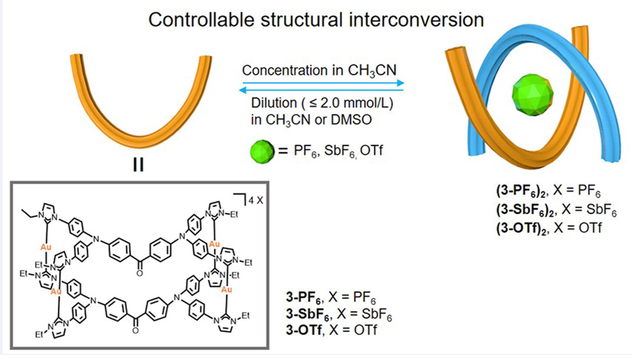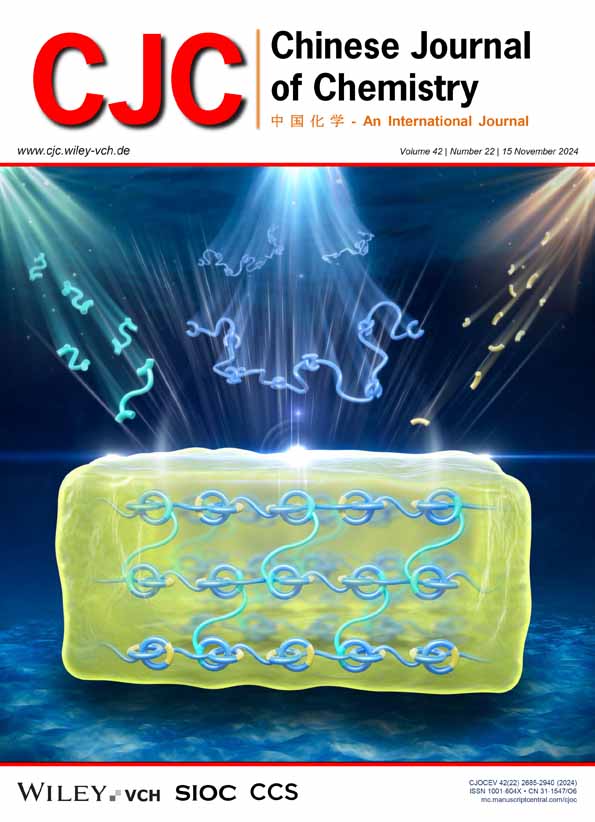Stimuli-Responsive Interconversion between Poly-NHC-Based Organometallic Assemblies and Their Self-Aggregated Dimers
Guang-Feng Jin
Key Laboratory of Synthetic and Natural Functional Molecule of the Ministry of Education, Xi'an Key Laboratory of Functional Supramolecular Structure and Materials, College of Chemistry and Materials Science, Northwest University, Xi'an, Shaanxi, 710127 China
Search for more papers by this authorCorresponding Author
Ying-Feng Han
Key Laboratory of Synthetic and Natural Functional Molecule of the Ministry of Education, Xi'an Key Laboratory of Functional Supramolecular Structure and Materials, College of Chemistry and Materials Science, Northwest University, Xi'an, Shaanxi, 710127 China
E-mail: [email protected]Search for more papers by this authorGuang-Feng Jin
Key Laboratory of Synthetic and Natural Functional Molecule of the Ministry of Education, Xi'an Key Laboratory of Functional Supramolecular Structure and Materials, College of Chemistry and Materials Science, Northwest University, Xi'an, Shaanxi, 710127 China
Search for more papers by this authorCorresponding Author
Ying-Feng Han
Key Laboratory of Synthetic and Natural Functional Molecule of the Ministry of Education, Xi'an Key Laboratory of Functional Supramolecular Structure and Materials, College of Chemistry and Materials Science, Northwest University, Xi'an, Shaanxi, 710127 China
E-mail: [email protected]Search for more papers by this authorComprehensive Summary
Poly-NHC-based organometallic assemblies 3-PF6, 3-SbF6 and 3-OTf were obtained and verified by NMR spectroscopy, ESI mass spectrometry and single-crystal X-ray diffraction analyses. Controllable structural interconversion was observed between the poly-NHC-based organometallic assemblies and their self-aggregated dimers in solution affected by concentration, solvent and metal ion. 1H NMR spectra of assembly 3-PF6 in CD3CN at different concentrations demonstrated controllable structural interconversion, and 19F NMR spectrum of assembly 3-PF6 at high concentration further evidenced the presence of the free hexafluorophosphate anion and encapsulated hexafluorophosphate anion for its two sets of signals. In addition, single-crystal X-ray diffraction analysis provided clear evidence that in the solid state, two assemblies 3-PF6 were vertically stuck, forming a self-aggregated dimer with an encapsulated hexafluorophosphate anion. Investigating the reversible structural interconversion is beneficial for revealing the intrinsic nature on the atom level and paving the way to design the stimuli-responsive functional system.

Supporting Information
| Filename | Description |
|---|---|
| cjoc202400501-sup-0001-supinfo.pdfPDF document, 2 MB |
Appendix S1: Supporting Information |
Please note: The publisher is not responsible for the content or functionality of any supporting information supplied by the authors. Any queries (other than missing content) should be directed to the corresponding author for the article.
References
- 1 Wang, W.; Wang, Y.-X.; Yang, H.-B. Supramolecular transformations within discrete coordination-driven supramolecular architectures. Chem. Soc. Rev. 2016, 45, 2656−2693.
- 2 McConnell, A. J.; Wood, C. S.; Neelakandan, P. P.; Nitschke, J. R. Stimuli-Responsive Metal–Ligand Assemblies. Chem. Rev. 2015, 115, 7729−7793.
- 3 Kang, N.; Son, S.; Min, S.; Hong, H.; Kim, C.; An, J.; Kim, J. S.; Kang, H. Stimuli-responsive ferroptosis for cancer therapy. Chem. Soc. Rev. 2023, 52, 3955−3972.
- 4 Song, B.-L.; Zhang, X.-H.; Qiao, Z.-Y.; Wang, H. Peptide-Based AIEgens: From Molecular Design, Stimuli Responsiveness to Biomedical Application. CCS Chem. 2022, 4, 437−455.
- 5 Xiong, R.; Xu, R. X.; Huang, C.; Smedt, S. D.; Braeckmans, K. Stimuli-responsive nanobubbles for biomedical applications. Chem. Soc. Rev. 2021, 50, 5746−5776.
- 6 Zhang, J.; He, B.; Hu, Y.; Alam, P.; Zhang, H.; Lam, J. W. Y.; Tang, B. Z. Stimuli-Responsive AIEgens. Adv. Mater. 2021, 33, 2008071.
- 7 Huang, Y.; Ning, L.; Zhang, X.; Zhou, Q.; Gong, Q.; Zhang, Q. Stimuli-fluorochromic smart organic materials. Chem. Soc. Rev. 2024, 53, 1090−1166.
- 8 Li, M.; Chen, L.-J.; Cai, Y.; Luo, Q.; Li, W.; Yang, H.-B.; Tian, H.; Zhu, W.-H. Light-Driven Chiral Switching of Supramolecular Metallacycles with Photoreversibility. Chem 2019, 5, 634−648.
- 9 Kakuta, T.; Yamagishi, T.-a.; Ogoshi, T. Stimuli-Responsive Supramolecular Assemblies Constructed from Pillar[n]arenes. Acc. Chem. Res. 2018, 51, 1656−1666.
- 10 Yuan, X.-Q.; Zhang, Y.-Q.; Li, Z.-Y.; Huo, F.; Dong, Y.-H.; He, H.-Y. Stimuli-Responsive Ionic Liquids and the Regulation of Aggregation Structure and Phase Behavior. Chin. J. Chem. 2021, 39, 729−744.
- 11 Gu, Y.; Alt, E. A.; Wang, H.; Li, X.; Willard, A. P.; Johnson, J. A. Photoswitching topology in polymer networks with metal–organic cages as crosslinks. Nature 2018, 560, 65−69.
- 12 Li, X.; Shen, M.; Yang, J.; Liu, L.; Yang, Y.-W. Pillararene-Based Stimuli-Responsive Supramolecular Delivery Systems for Cancer Therapy. Adv. Mater. 2024, 36, 2313317.
- 13 Kim, T. Y.; Vasdev, R. A. S.; Preston, D.; Crowley, J. D. Strategies for Reversible Guest Uptake and Release from Metallosupramolecular Architectures. Chem. Eur. J. 2018, 24, 14878−14890.
- 14 Blanco-Gómez, A.; Cortón, P.; Barravecchia, L.; Neira, I.; Pazos, E.; Peinador, C.; García, M. D. Controlled binding of organic guests by stimuli-responsive macrocycles. Chem. Soc. Rev. 2020, 49, 3834−3862.
- 15 Wu, H.; Chen, Y.; Zhang, L.; Anamimoghadam, O.; Shen, D.; Liu, Z.; Cai, K.; Pezzato, C.; Stern, C. L.; Liu, Y.; Stoddart, J. F. A Dynamic Tetracationic Macrocycle Exhibiting Photoswitchable Molecular Encapsulation. J. Am. Chem. Soc. 2019, 141, 1280−1289.
- 16 Krykun, S.; Dekhtiarenko, M.; Canevet, D.; Carré, V.; Aubriet, F.; Levillain, E.; Allain, M.; Voitenko, Z.; Sallé, M.; Goeb, S. Metalla-Assembled Electron-Rich Tweezers: Redox-Controlled Guest Release Through Supramolecular Dimerization. Angew. Chem. Int. Ed. 2020, 59, 716−720.
- 17 Chen, L. J.; Yang, H. B. Construction of Stimuli-Responsive Functional Materials via Hierarchical Self-Assembly Involving Coordination Interactions. Acc. Chem. Res. 2018, 51, 2699−2710.
- 18 Li, Z. Y.; Zhang, Y.; Zhang, C. W.; Chen, L. J.; Wang, C.; Tan, H.; Yu, Y.; Li, X.; Yang, H. B. Cross-Linked Supramolecular Polymer Gels Constructed from Discrete Multi-pillar[5]arene Metallacycles and Their Multiple Stimuli-Responsive Behavior. J. Am. Chem. Soc. 2014, 136, 8577−8589.
- 19 Cullen, W.; Turega, S.; Hunter, C. A.; Ward, M. D. pH-dependent binding of guests in the cavity of a polyhedral coordination cage: reversible uptake and release of drug molecules. Chem. Sci. 2015, 6, 625−631.
- 20 Giglio, V.; Varela-Aramburu, S.; Travaglini, L.; Fiorini, F.; Seeberger, P. H.; Maggini, L.; Cola, L. D. Reshaping silica particles: Mesoporous nanodiscs for bimodal delivery and improved cellular uptake. Chem. Eng. J. 2018, 340, 148−154.
- 21 Han, M.; Luo, Y.; Damaschke, B.; Gomez, L.; Ribas, X.; Jose, A.; Peretzki, P.; Seibt, M.; Clever, G. H. Light-Controlled Interconversion between a Self-Assembled Triangle and a Rhombicuboctahedral Sphere. Angew. Chem. Int. Ed. 2016, 55, 445−449.
- 22 Yan, L.-L.; Yam, V. W.-W. Photo- and Temperature-Induced Reversible Structural Transformation between Dodecanuclear and Pentadecanuclear Gold(I) Sulfido Complexes. J. Am. Chem. Soc. 2023, 145, 7454−7461.
- 23 Wiester, M. J.; Braunschweig, A. B.; Yoo, H.; Mirkin, C. A. Solvent and Temperature Induced Switching Between Structural Isomers of RhI Phosphinoalkyl Thioether (PS) Complexes. Inorg. Chem. 2010, 49, 7188−7196.
- 24 Cai, L.-X.; Yan, D.-N.; Cheng, P.-M.; Xuan, J.-J.; Li, S.-C.; Zhou, L.-P.; Tian, C.-B.; Sun, Q.-F. Controlled Self-Assembly and Multistimuli-Responsive Interconversions of Three Conjoined Twin-Cages. J. Am. Chem. Soc. 2021, 143, 2016−2024.
- 25 Xu, G.-T.; Wu, L.-L.; Chang, X.-Y.; Ang, T. W. H.; Wong, W.-Y.; Huang, J.-S.; Che, C.-M. Solvent-Induced Cluster-to-Cluster Transformation of Homoleptic Gold(I) Thiolates between Catenane and Ring-in-Ring Structures. Angew. Chem. Int. Ed. 2019, 58, 16297−16306.
- 26 Yan, L.-L.; Yao, L.-Y.; Yam, V. W.-W. Concentration- and Solvation-Induced Reversible Structural Transformation and Assembly of Polynuclear Gold(I) Sulfido Complexes. J. Am. Chem. Soc. 2020, 142, 11560−11568.
- 27 Wang, S.; Sawada, T.; Ohara, K.; Yamaguchi, K.; Fujita, M. Capsule–Capsule Conversion by Guest Encapsulation. Angew. Chem. Int. Ed. 2016, 55, 2063−2066.
- 28 Wood, D. M.; Meng, W.; Ronson, T. K.; Stefankiewicz, A. R.; Sanders, J. K.; Nitschke, J. R. Guest-Induced Transformation of a Porphyrin-Edged FeII4L6 Capsule into a CuIFeII2L4 Fullerene Receptor. Angew. Chem. Int. Ed. 2015, 54, 3988−3992.
- 29 Riddell, I. A.; Smulders, M. M.; Clegg, J. K.; Hristova, Y. R.; Breiner, B.; Thoburn, J. D.; Nitschke, J. R. Anion-induced reconstitution of a self-assembling system to express a chloride-binding Co10L15 pentagonal prism. Nat. Chem. 2012, 4, 751−756.
- 30 Sekiya, R.; Fukuda, M.; Kuroda, R. Anion-Directed Formation and Degradation of an Interlocked Metallohelicate. J. Am. Chem. Soc. 2012, 134, 10987−10997.
- 31 Lu, X.; Li, X.; Guo, K.; Xie, T.-Z.; Moorefield, C. N.; Wesdemiotis, C.; Newkome, G. R. Probing a Hidden World of Molecular Self-Assembly: Concentration-Dependent, Three-Dimensional Supramolecular Interconversions. J. Am. Chem. Soc. 2014, 136, 18149−18155.
- 32 Endo, K.; Ube, H.; Shionoya, M. Multi-Stimuli-Responsive Interconversion between Bowl- and Capsule-Shaped Self-Assembled Zinc(II) Complexes. J. Am. Chem. Soc. 2020, 142, 407−416.
- 33 Roberts, D. A.; Pilgrim, B. S.; Sirvinskaite, G.; Ronson, T. K.; Nitschke, J. R. Covalent Post-Assembly Modification Triggers Multiple Structural Transformations of a Tetrazine-Edged Fe4L6 Tetrahedron. J. Am. Chem. Soc. 2018, 140, 9616−9623.
- 34 Bai, S.; Han, Y.-F. Metal-N-Heterocyclic Carbene Chemistry Directed toward Metallosupramolecular Synthesis and Beyond. Acc. Chem. Res. 2023, 56, 1213−1227.
- 35 Ibáñez, S.; Poyatos, M.; Peris, E. N-Heterocyclic Carbenes: A Door Open to Supramolecular Organometallic Chemistry. Acc. Chem. Res. 2020, 53, 1401−1413.
- 36 Jin, G.-F.; Zhang, Y.-Z.; Yu, L.; Jiang, W.-L.; Li, Y.; Sun, L.-Y.; Li, P.; Han, Y.-F. Radical Organometallic Nanocages with Redox Switchable Poly-NHC Ligands. Nano Res. 2023, 16, 10678−10683.
- 37 Zhang, H.; Li, Y.; Zhang, Y.-F.; Qiao, X.-J.; Sun, L.-Y.; Li, J.; Wang, Y.-Y.; Han, Y.-F. Solvato-Controlled Assembly and Structural Transformation of Emissive Poly-NHC-Based Organometallic Cages and Their Applications in Amino Acid Sensing and Fluorescence Imaging. Chem. Eur. J. 2023, 29, e202300209.
- 38 Li, Y.; Yang, T.; Li, N.; Bai, S.; Li, X.; Ma, L.-L.; Wang, K.; Zhang, Y.; Han, Y.-F. Multistimuli-Responsive Fluorescent Organometallic Assemblies Based on Mesoionic Carbene-Decorated Tetraphenylethene Ligands and Their Applications in Cell Imaging. CCS Chem. 2022, 4, 732−743.
- 39 Li, M.; Li, Y.; Li, X.; Wang, F.; Han, Y.-F. An Ultralong Low-Temperature Phosphorescent Pentagonal-Prismatic Organometallic Cylinder Featuring Pentaphenyl-pyrrole-N-Heterocyclic Carbenes. Chin. J. Chem. 2023, 41, 1431–1436.
- 40 Wang, Y.-S.; Sun, L.-Y.; Wang, Y.-Y.; Han, Y.-F. Phase-mediated controllable intramolecular and intermolecular photocycloadditions assisted by supramolecular templates. Sci. China Chem. 2022, 65, 1129−1133.
- 41 Gan, M.-M.; Zhang, Z.-E.; Zhang, Y.-F.; Zhang, H.; Sun, L.-Y.; Han, Y.-F. Supramolecular polymer network constructed by a functionalized polyimidazolium salt derived from metal-carbene template approach. Sci. China Chem. 2024, 67, 1224−1228.
- 42 Rit, A.; Pape, T.; Hahn, F. E. Self-Assembly of Molecular Cylinders from Polycarbene Ligands and AgI or AuI. J. Am. Chem. Soc. 2010, 132, 4572–4573.




